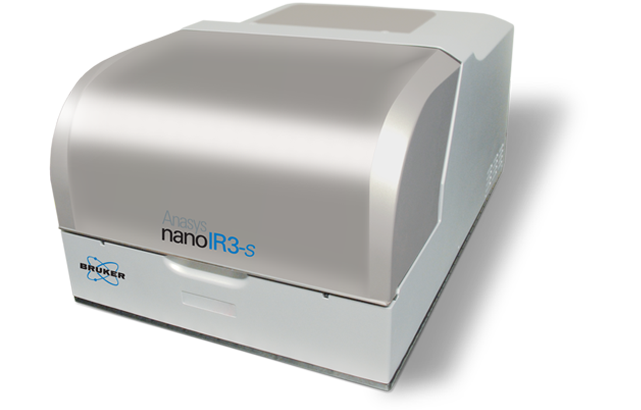Anasys nanoIR3-s
Anasys nanoIR3-s
Bruker's Anasys nanoIR3-s system combines scattering scanning near-field optical microscopy (s-SNOM) and nanoscale IR spectroscopy (AFM-IR) with an integrated atomic force microscope (AFM), all in a single platform. Building upon the legacy of Anasys technology leadership in AFM-based nano-optical characterization, nanoIR3-s provides nanoscale IR spectroscopy, chemical imaging, and optical property mapping with 10-nanometer spatial resolution demonstrated on 2D material samples. The system also enables AFM topographic imaging and material property mapping with nanometer-scale resolution, making it an ideal instrument for correlative studies across a wide range of material science applications. The nanoIR3-s with broadband option adds the latest OPO/DFG femtosecond laser technology to provide the broadest available spectral range (670 to 4000 cm⁻¹) with high-resolution nanochemical and nano-optical imaging capabilities.
To learn more, continue reading, contact us, or see FAQs about this product.
10nm Spatial Resolution Chemical Imaging and Spectroscopy
Graphene Plasmonics
High-Resolution Property Mapping
High-Performance Nano FTIR Spectroscopy
NanoIR3-s provides:
- High-performance nano FTIR spectroscopy;
- High-performance IR SNOM spectroscopy with the most advanced nanoIR laser source available;
- nano FTIR spectroscopy with integrated DFG, continuum based laser source Broadband synchrotron light source integration; and
- Multi-chip QCL laser source for spectroscopy and chemical imaging.
POINTspectra Technology
POINTspectra lasers enable both spectroscopy and high-resolution optical property mapping across a broad range of wavelengths. With nanoIR3-s it is a simple task to generate correlated data:
- Select feature to be measured in the AFM image
- Measure spectroscopy of sample and select wavelength of interest
- Create high-resolution optical property map
Broadband Laser Option
Nanoscale FTIR spectroscopy with the broadest available spectral range (670 to 4000 cm⁻¹)
Equipped with optional OPO/DFG femtosecond laser technology, the nanoIR3-s system delivers the broadest spectral range to enable high-performance combined spectroscopy and high-resolution nanochemical imaging. This unique set of capabilities enables research in a broad range of research areas in historically inaccessible spectral regions.
Complementary high-resolution imaging
High-quality, high-resolution nano-optical images can be generated for characterization of a wide range of optical phenomena, such as graphene plamonics and surface phonon polaritons in hexagonal boron nitride (hBN), and chemical imaging of biological and other organic samples.
Frequently Asked Questions
Yes, nanoIR3-s combines AFM-IR with s-SNOM capabilities for advanced studies of plasmonic, photonic, and electronic materials. Offering multimodal nanospectral analysis.
nanoIR3-s offers Tapping AFM-IR and Resonance Enhanced AFM-IR as standard, and can be equipped with Surface Sensitive AFM-IR if the appropriate lasers and probes are included in the configuration.
External-source coupling is possible but should be discussed with Bruker to ensure compatibility.
More About Bruker's Nanoscale Infrared Technology
Yes. Bruker’s photothermal AFM-IR technology produces spectra that are directly comparable to FTIR spectra, as demonstrated in published documentation and peer-reviewed articles. AFM-IR spectra can be searched directly against FTIR spectral databases. If FTIR-like spectral analysis is critical for your application, our experts can provide evidence showing spectral correlation.
Photothermal AFM-IR provides direct absorption-based spectra that closely match FTIR results and are easier to interpret than Raman-AFM or s-SNOM. Further, Photothermal AFM-IR signals are amplified by the resonant enhancement of the cantilever providing the best signal-to-noise of those techniques. Bruker offers s-SNOM as a separate option for advanced near-field studies.
Bruker nanoIR systems routinely achieve chemical imaging with spatial resolution below 10 nm and can detect single molecular layers. Actual performance depends on your sample and selected measurement mode.
Yes, photothermal AFM-IR can chemically map and identify particles smaller than one micron, including nanoplastics and environmental contaminants. Direct correlation to FTIR provides ready interpretation in particles as small as 10 nm.
Bruker’s photothermal AFM-IR systems typically require a single socket of standard electrical power,and CDA. Specific requirements may vary by model, so request a site preparation guide from your Bruker representative.
Bruker photothermal AFM-IR systems primarily use quantum cascade lasers (QCLs) that deliver stable, reliable performance and broad coverage across the mid-infrared fingerprint region as well as optical parametric oscillators (OPOs) for the C-H, O-H, N-H stretching region. Multiple QCL chips can be combined to access all key spectral windows required for routine and advanced research, and additional sources are available for specialized applications. Bruker’s application experts can help you select the optimal laser configuration to match your measurement needs and ensure sufficient spectral resolution for both standard and demanding experiments.
Measurement times vary by application, but point spectra can be acquired in seconds, chemical maps in minutes, and automated recipes can be tailored for high-throughput workflows.
Routine maintenance includes probe replacement, laser alignment checks, and calibration with reference samples. Bruker provides detailed maintenance protocols and support plans.
